Kyoto, once the imperial capital of Japan, is a city that beautifully merges ancient tradition with serene landscapes. Known for its stunning temples, historic shrines, and vibrant cultural heritage, Kyoto offers an enriching experience for travelers seeking to explore Japan’s rich history and natural beauty. Here’s a guide to some of the must-visit destinations in Kyoto:

1. Fushimi Inari Taisha
No visit to Kyoto is complete without exploring Fushimi Inari Taisha, one of the city’s most iconic and spiritually significant landmarks. This renowned Shinto shrine is famous for its thousands of vibrant vermilion torii gates, which form a stunning, winding tunnel that ascends Mount Inari. Each gate is inscribed with the names of the donors and the date of donation, contributing to the shrine’s rich tapestry of history and devotion.
The journey through the torii gates is nothing short of magical. As visitors walk beneath the towering gates, they are enveloped in a serene and almost otherworldly atmosphere. The path gradually ascends through the wooded mountainside, passing smaller shrines and offering spots along the way. This route is not just a physical trek but a deeply spiritual journey, reflecting the importance of the shrine in Japanese Shinto beliefs.
Fushimi Inari Taisha is dedicated to Inari, the Shinto deity of rice, agriculture, and fertility, making it a revered site for those seeking blessings for bountiful harvests and prosperity. The shrine’s history dates back to the 8th century, and its significance is evident in the countless rituals and ceremonies held here.
As visitors continue their ascent, they are rewarded with breathtaking panoramic views of Kyoto and the surrounding landscapes from the summit. The expansive vistas offer a stunning contrast to the dense forest and vibrant gates, providing a perfect vantage point to appreciate the natural beauty of the region.
Beyond its visual splendor, Fushimi Inari Taisha also offers a profound cultural and spiritual experience. The shrine’s serene environment and the rhythmic sound of footsteps on the path create a meditative atmosphere, inviting visitors to reflect and connect with the spiritual heritage of Japan.
Whether you’re drawn by its architectural beauty, spiritual significance, or the panoramic views from the top, Fushimi Inari Taisha is an unforgettable highlight of any trip to Kyoto.
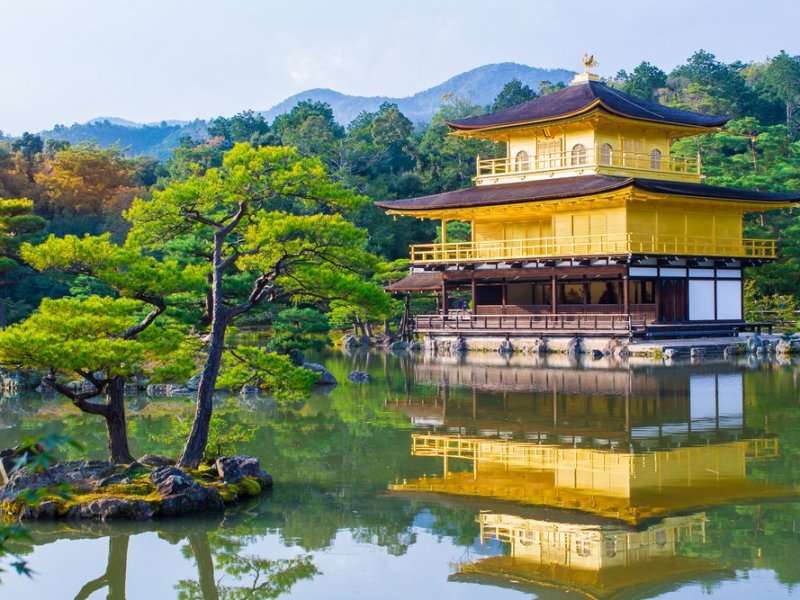
2. Kinkaku-ji (Golden Pavilion):
Kinkaku-ji, also known as the Golden Pavilion, stands as one of Kyoto’s most iconic and cherished landmarks. This renowned Zen Buddhist temple is celebrated for its breathtakingly beautiful design and its serene, reflective setting.
Constructed in 1397 as a retirement villa for the shogun Ashikaga Yoshimitsu, Kinkaku-ji was converted into a Zen temple following his death. The structure is famous for its striking golden facade, which gleams with a radiant luster thanks to the gold leaf applied to its exterior. This dazzling appearance is especially captivating when the temple’s reflection shimmers across the serene pond that encircles it. The interplay of light and reflection creates a picture-perfect scene that has been admired by visitors for centuries.
The temple is set amidst a beautifully landscaped garden, meticulously designed to enhance the aesthetic harmony of the site. The gardens, featuring meticulously pruned trees, flowing streams, and strategically placed rocks, complement the temple’s architectural splendor and add to the overall sense of tranquility. Each season brings a different charm to Kinkaku-ji, from the vibrant greens of summer to the soft hues of autumn, making it a year-round destination for contemplation and reflection.
Walking around the pond, visitors can enjoy various viewpoints of the Golden Pavilion, each offering a unique perspective of its beauty. The surrounding landscape is carefully crafted to reflect the principles of traditional Japanese garden design, emphasizing balance, harmony, and the seamless integration of natural elements.
Kinkaku-ji is not only a visual marvel but also a symbol of Kyoto’s rich cultural heritage and Zen Buddhist philosophy. The pavilion embodies the principles of Zen, inviting visitors to pause and find a moment of peace in the midst of its serene environment.
Whether you’re drawn to its architectural brilliance, its tranquil gardens, or its reflective pond, Kinkaku-ji offers an unforgettable experience that captures the essence of Kyoto’s historical and spiritual legacy.
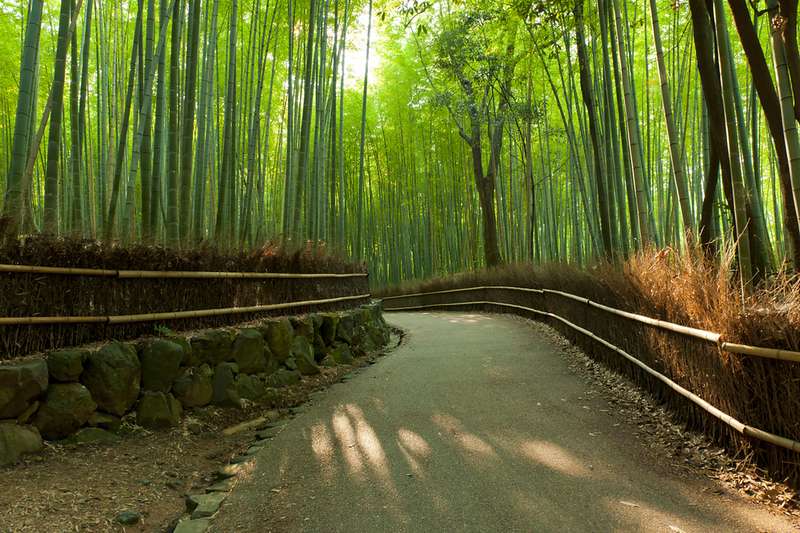
3. Arashiyama Bamboo Grove
Immerse yourself in the enchanting atmosphere of the Arashiyama Bamboo Grove, a mesmerizing natural wonder nestled in the western part of Kyoto. This bamboo forest, renowned for its ethereal beauty, offers a unique and tranquil experience that feels almost otherworldly.
As you step into the Arashiyama Bamboo Grove, you are immediately enveloped by the towering stalks of bamboo that sway gently in the breeze. The bamboo can reach heights of up to 50 feet, creating a towering canopy that filters the sunlight into soft, dappled patterns on the forest floor. This interplay of light and shadow enhances the serene and mystical ambiance of the grove, making each visit a deeply immersive experience.
The rustling of the bamboo leaves creates a soothing, rhythmic sound that adds to the grove’s tranquil atmosphere. Walking along the well-maintained paths, visitors can lose themselves in the hushed whispers of the bamboo and the calming sensation of being surrounded by nature’s splendor. The experience is enhanced by the cool, fresh air and the soft, green glow of the bamboo, providing a refreshing escape from the bustle of city life.
While exploring the Arashiyama Bamboo Grove, don’t miss the opportunity to visit the nearby Tenryu-ji Temple, a UNESCO World Heritage site and one of Kyoto’s most significant Zen temples. Established in 1339, Tenryu-ji is renowned for its beautifully landscaped gardens that harmoniously blend with the natural surroundings. The temple’s gardens, designed in the traditional Japanese style, feature carefully arranged ponds, rocks, and seasonal flowers that reflect the changing seasons and complement the serene atmosphere of the grove.
The temple grounds also include the famous Sogenchi Garden, which offers picturesque views of the surrounding mountains and provides a perfect complement to the bamboo grove’s natural beauty. The combination of the temple’s historical significance and the garden’s tranquil design makes Tenryu-ji a must-visit destination while in the Arashiyama area.
Whether you’re drawn to the breathtaking beauty of the bamboo forest, the peaceful ambiance of the temple gardens, or both, a visit to the Arashiyama Bamboo Grove and Tenryu-ji Temple offers a magical journey into Kyoto’s natural and cultural.
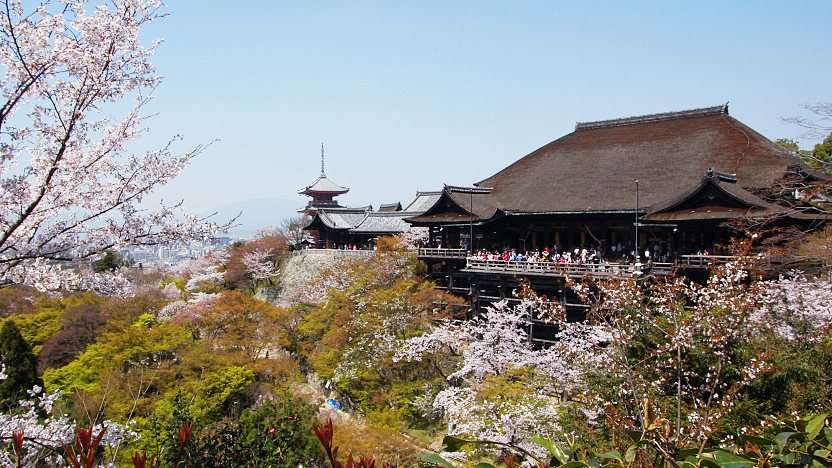
4. Kiyomizu-dera
Perched on a hillside overlooking Kyoto, Kiyomizu-dera is a historic and iconic temple that offers a profound connection to the city’s rich cultural and natural heritage. Established in 778 AD, this renowned Buddhist temple is celebrated for its stunning architecture and its breathtaking panoramic views of Kyoto and the surrounding hills.
One of the most striking features of Kiyomizu-dera is its wooden stage that extends dramatically out over the hillside, supported by hundreds of wooden pillars. This expansive platform provides visitors with an awe-inspiring vista of the city below and the lush, green hills that encircle it. The view from this stage is particularly spectacular during the changing seasons, offering a dynamic backdrop of vibrant cherry blossoms in spring and rich hues of red and gold during autumn. The sight of the temple’s stage seemingly floating in mid-air, surrounded by a sea of foliage, is nothing short of magical.
The temple’s name, Kiyomizu-dera, translates to “Pure Water Temple,” a reference to the Otowa Waterfall that flows beneath the temple’s stage. This sacred spring is integral to the temple’s spiritual significance and is believed to have healing properties. Visitors often gather at the temple’s base to drink from the clear, cold waters of the Otowa Waterfall, seeking blessings for health and longevity.
Kiyomizu-dera’s architectural and cultural significance extends beyond its stunning views. The temple complex features beautifully crafted pagodas, serene gardens, and a host of historical artifacts that reflect its long-standing heritage. The main hall, or Hondo, is a testament to traditional Japanese temple architecture, with its elegant wooden beams and intricate carvings.
The temple is also home to several revered statues and deities, including Kannon, the Buddhist goddess of mercy, who is central to the temple’s spiritual practices. Pilgrims and tourists alike come to Kiyomizu-dera not only to admire its architectural beauty but also to engage in personal reflection and seek spiritual solace.
During special times of the year, such as the Kiyomizu-dera Night Illumination events, the temple is illuminated with thousands of lights, creating a mesmerizing and ethereal atmosphere that transforms the site into a glowing wonderland.
Whether visiting for its architectural marvels, its spiritual significance, or its stunning seasonal views, Kiyomizu-dera offers a memorable and enriching experience that captures the essence of Kyoto’s historical and natural be.
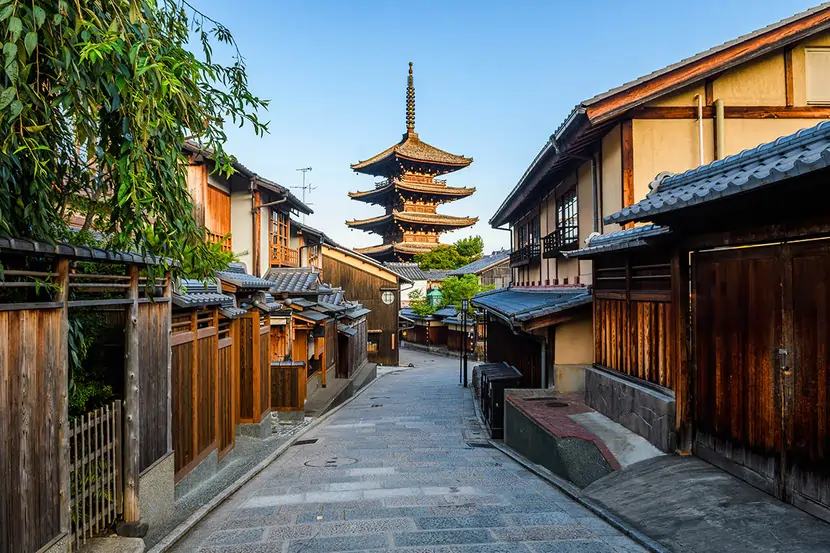
5. Gion District
Step back in time by wandering through the historic Gion District, one of Kyoto’s most famous and atmospheric neighborhoods. Renowned for its deep-rooted cultural heritage, Gion is Kyoto’s geisha district, offering a unique glimpse into the traditional practices and elegant lifestyle of Japan’s iconic performing arts.
As you stroll through Gion’s charming streets, you’ll encounter traditional wooden machiya houses that have been preserved for centuries. These historic townhouses, with their distinctive latticework and sliding doors, exude an old-world charm that transports visitors to a bygone era. The architectural style of the machiya houses reflects the elegance and craftsmanship of traditional Kyoto, creating a picturesque setting for exploration.
Gion is particularly renowned for its vibrant tea culture. The district is home to a number of charming teahouses where visitors can experience the art of traditional Japanese tea ceremonies. These teahouses, often tucked away down narrow alleys, offer a serene environment to enjoy matcha (powdered green tea) and traditional sweets, while also providing insight into Kyoto’s rich cultural rituals.
A highlight of any visit to Gion is the opportunity to spot a geisha or a maiko (apprentice geisha). As you wander the streets, especially in the early evening, you might catch a glimpse of these graceful women in their elaborate kimonos and intricate hairstyles, gracefully moving between their appointments. The presence of geisha and maiko adds an air of authenticity and elegance to the district, offering visitors a rare and enchanting cultural experience.
In addition to its cultural and historical significance, Gion is a vibrant hub for traditional crafts and cuisine. The district is dotted with small shops and boutiques where you can find handcrafted souvenirs, such as exquisite kimonos, delicate ceramics, and intricately designed fans. Local eateries and restaurants provide a delectable opportunity to sample Kyoto’s unique cuisine, including specialties such as kaiseki (traditional multi-course meal), yudofu (tofu hot pot), and sweet treats like yatsuhashi (cinnamon rice cakes).
Gion also hosts several traditional festivals throughout the year, such as the Gion Matsuri, one of Japan’s most famous festivals. During this time, the streets come alive with vibrant processions, colorful floats, and festive activities, offering an immersive cultural experience.
Whether you’re exploring its historic architecture, enjoying a tea ceremony, or simply soaking in the atmosphere of this storied district, Gion provides a captivating journey into Kyoto’s rich cultural tapestry and timeless charm.

6. Nijo Castle
Nijo Castle, a distinguished UNESCO World Heritage site, stands as a magnificent testament to Japan’s feudal history and architectural splendor. Located in the heart of Kyoto, this historic castle complex offers a captivating glimpse into the grandeur of Japan’s Shogunate era, showcasing the artistry and sophistication of traditional Japanese castle design.
Built in 1603 by Tokugawa Ieyasu, the founder of the Tokugawa Shogunate, Nijo Castle was originally constructed as a residence for the shogun during his visits to Kyoto. The castle’s design embodies the elegance and power of the Tokugawa era, reflecting the high status and authority of its occupants.
One of the most striking features of Nijo Castle is its ornate interiors, which include richly decorated rooms and elaborate woodwork. The castle’s Ninomaru Palace, the primary residence within the castle grounds, is renowned for its beautifully painted sliding doors, intricate wood carvings, and opulent furnishings. Each room is adorned with exquisite details that reflect the artistic and cultural achievements of the period, providing visitors with a sense of the luxury and sophistication enjoyed by the shogun and his court.
The castle grounds are equally impressive, featuring expansive gardens that are meticulously designed to complement the castle’s architecture. The gardens include picturesque ponds, carefully sculpted rock formations, and seasonal plantings that offer a serene and picturesque setting throughout the year. The combination of the castle’s architectural grandeur and its beautifully landscaped gardens creates a harmonious and tranquil environment that is a delight to explore.
One of the most unique and intriguing aspects of Nijo Castle is its “nightingale floors”, so named for the distinctive chirping sound they make when walked upon. This clever architectural feature was designed to serve as a security measure, alerting the occupants to any intruders. The floors consist of specially constructed wooden planks that produce a melodious sound, adding a layer of historical intrigue to the castle experience.
As you wander through the castle’s spacious courtyards, explore the richly adorned rooms, and stroll through the lush gardens, Nijo Castle offers a fascinating journey into the past. The castle not only reflects the political power and cultural achievements of the Tokugawa Shogunate but also provides a vivid portrayal of the artistic and architectural sophistication that characterized Japan’s feudal era.
Nijo Castle’s status as a UNESCO World Heritage site underscores its significance as a cultural and historical landmark. It remains a must-visit destination for those interested in Japanese history, architecture, and the legacy of the Shogunate period. Whether you are drawn to its intricate interiors, historical features, or beautiful gardens, Nijo Castle offers an enriching and immersive experience that captures the essence of Japan’s rich heritage.

7. Philosopher’s Path
For a peaceful stroll, the Philosopher’s Path is a charming and evocative walkway that stretches alongside a serene canal in Kyoto. This picturesque path, named after the renowned philosopher Nishida Kitaro, offers an enchanting escape from the hustle and bustle of the city, providing visitors with a tranquil and contemplative environment.
The Philosopher’s Path follows the gentle course of the Canal of the Kamo River, meandering through a lush landscape of cherry trees, which create a stunning natural canopy over the walkway. The path is particularly renowned for its beauty during cherry blossom season (sakura season), typically in early April, when the cherry trees burst into bloom, showering the path with delicate pink petals. This ephemeral display of nature’s beauty transforms the walkway into a dreamlike corridor, perfect for leisurely strolls, photography, and reflection.
As you walk along the Philosopher’s Path, you’ll find the tranquil atmosphere enhanced by the gentle sounds of the flowing canal and the rustling of leaves in the breeze. The path’s serene environment makes it an ideal spot for meditation and introspection, echoing the contemplative practice of Nishida Kitaro, who is said to have meditated while walking this very route.
Throughout the year, the Philosopher’s Path offers a picturesque experience, with each season bringing its own unique charm. In autumn, the walkway is adorned with brilliant hues of red and gold as the maple leaves change color, creating a vibrant tapestry of fall foliage. In summer, the lush greenery provides a refreshing and cool retreat, while in winter, the path’s quiet and muted beauty invites a peaceful, reflective experience.
Along the Philosopher’s Path, you’ll encounter a variety of traditional teahouses, quaint shops, and historic sites. The path passes by several notable temples and shrines, including Ginkaku-ji (Silver Pavilion), a UNESCO World Heritage site, and Eikan-do Temple, both of which add cultural and historical depth to your stroll.
Whether you’re seeking a quiet escape for reflection, enjoying a leisurely walk amidst nature, or exploring the cultural landmarks along the way, the Philosopher’s Path provides a serene and evocative experience that beautifully captures Kyoto’s timeless charm and natural be.
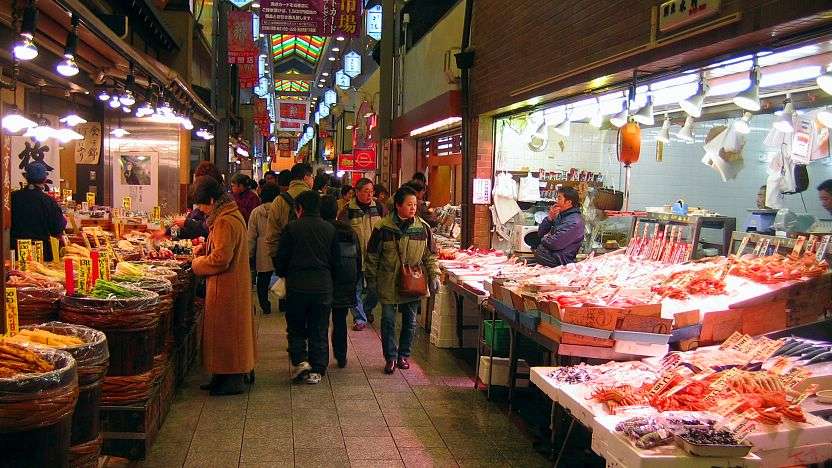
8. Nishiki Market
Food lovers will delight in Nishiki Market, often referred to as “Kyoto’s Kitchen,” which stands as a bustling epicenter of culinary culture and tradition in Kyoto. This vibrant marketplace, stretching over five blocks, offers an immersive experience into the rich and diverse world of Japanese food, making it a must-visit destination for anyone passionate about gastronomy.
Nishiki Market is renowned for its array of fresh seafood, including succulent sashimi, oysters, and grilled fish, all showcasing the finest catches from Japan’s coastal waters. The market’s seafood stalls are a feast for the senses, with displays of vibrant, freshly prepared dishes that highlight the quality and variety of Kyoto’s marine bounty.
In addition to seafood, the market is famous for its pickles (tsukemono), which come in a wide range of flavors and textures. These traditional Japanese side dishes, often served with rice, are prepared using time-honored techniques and local ingredients, offering visitors a taste of Kyoto’s rich culinary heritage. The colorful arrays of pickles, displayed in wooden barrels and jars, add a visually appealing and aromatic element to the market experience.
Nishiki Market is also home to a delightful selection of sweets (wagashi), including delicate mochi, traditional rice cakes, and seasonal confections. These treats often feature intricate designs and flavors that reflect Japanese seasonal themes, offering a sweet indulgence that complements the market’s savory offerings.
Beyond its diverse food stalls, Nishiki Market provides a vibrant and engaging atmosphere that captures the essence of a traditional Japanese market. As you wander through the narrow aisles, you’ll encounter a lively array of vendors calling out their wares, the enticing aromas of freshly cooked foods, and the lively chatter of locals and visitors alike. The market is not only a place to shop but also a space to interact with vendors, learn about Japanese ingredients and culinary techniques, and immerse yourself in the cultural experience of Kyoto’s food scene.
In addition to its food offerings, Nishiki Market features specialty shops selling kitchenware, local spices, and artisanal products. These shops provide opportunities to purchase unique souvenirs and cooking ingredients that can bring a taste of Kyoto’s culinary tradition into your own kitchen.
Whether you’re looking to sample local delicacies, experience the vibrant market atmosphere, or explore the diverse array of Japanese food, Nishiki Market offers an unforgettable journey into Kyoto’s gastronomic landscape, making it a highlight for food enthusiasts and curious travelers alike.
Conclusion
Kyoto is a city where the past and present intertwine seamlessly, offering a rich tapestry of cultural experiences, historical landmarks, and natural beauty. Whether you’re exploring ancient temples, wandering through serene gardens, or savoring local delicacies, Kyoto promises a memorable and enriching journey through one of Japan’s most captivating cities.
Feel free to adjust any details or add more specific destinations based on your interests!
YOU MY ALSO LIKE




